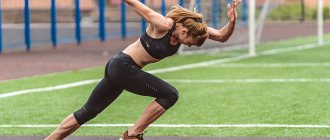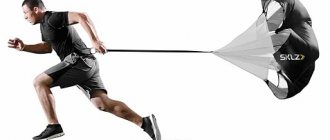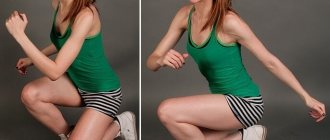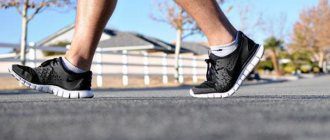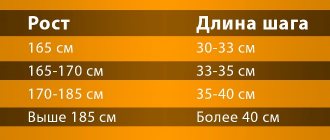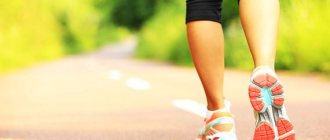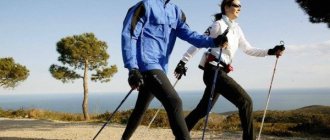Race walking will help you strengthen your body, become more resilient and create an ideal figure. Anyone can practice this sport. To do this you need to know the rules and techniques. Let's try to figure out how to practice race walking correctly, and what race walking should be like for beginners.
Type of sport: race walking
Many people who lead a healthy lifestyle know what race walking is. This is one of the Olympic sports, the peculiarity of which is the presence of constant support. This technique differs from the usual walking by a different pace, step length, and positioning of the legs. Race walking can be called health-improving, since it has a positive effect on the functioning of all organs and systems. By doing this sport, you can lose weight and strengthen your muscles.
How is race walking different from running?
Race walking differs from running in rules, technique and speed of movement. The main requirement for race walking is to step straight and rest on your heel. One leg is in contact with the surface, and the projection of the body is in a vertical position. Experienced athletes highlight the following differences between running and this sport:
- When running, the athlete lifts both legs at once between touches to the ground, and when walking, one leg makes the movement.
- When running, a low start is allowed, and during race walking - only a full start.
- The rules of race walking allow you to keep your leg straight when stepping, and bent when running.
- Running is many times faster than walking, but the latter sport is much more rhythmic.
- When running, the foot is subjected to six times the load, which can lead to serious damage. Race walking is safer.
Difference between RUNNING, WALKING and JOGGING
The difference between running, jogging and walking lies in two interrelated features - energy expenditure and muscle load. In fact, all of the above are ways to move our body in space using exclusively our own muscles. Walking is easy to distinguish from running, but the difference between running and jogging causes some confusion.
The easiest way to measure energy expenditure is to calculate the cost of breathing. We burn approximately five calories for every liter of oxygen, and the more muscles we use, the more oxygen we require and the faster and deeper we breathe. This is how the difference in physical fitness is smoothed out, when the jogging speed of an Olympic athlete for a beginner is more reminiscent of a sprint due to the better aerobic fitness and high endurance of the former. An Olympian's jogging speed is determined by muscle load and the oxygen demands of his lungs.
Therefore, the most common definition of jogging as running at a speed at which you can carry on a conversation is correct. This means that the oxygen consumption of the lungs is not high enough for full running.
Walking, although simple, requires increasing energy expenditure as speed increases. We begin to breathe harder, and then, having reached a certain limit of energy efficiency, a biological optimization mechanism is activated and we “switch gears.” A walker at a speed of 8 km/h spends more oxygen than a person running at the same speed. The moment we reach this limit, we switch to jogging, which significantly reduces energy costs.
The transition from walking to jogging occurs automatically to optimize movement and energy expenditure. This must be kept in mind for those who want to maintain a certain weight through running. Walking briskly (especially with weights) will burn more calories than jogging, and jogging at a slow pace will not necessarily require more effort than jogging quickly.
How much energy do we spend running?
One of the most common mistakes when accounting for the energy spent on a run is when we don't take into account the calories that we would burn just watching TV on the couch. This indicator is called basal calorie expenditure (BCR). To find out how many calories we spend on exercise, we need to take the total calorie expenditure (TCC) and subtract the TBC, which will give us a net calorie expenditure, which will tell us whether we deserve a tasty treat as a reward.
Due to the biological adaptability of our bodies, running has another advantage over walking or jogging - increased energy expenditure. Fast and Furious is a brief state during and after intense training in which our energy expenditure is higher than our total calorie expenditure.
This is why high-intensity interval training is so effective, and running at a maximum pace brings visible results faster than walking.
Typically, running burns twice as many calories as walking, excluding afterburners. Energy consumption during a strenuous walk with weights may be higher than during leisurely jogging.
If walking is your main method of cardiovascular training, then you need to walk twice as far to burn the same amount of energy as jogging the same distance. That is, to obtain energy expenditure of the same level, it is necessary to equate one kilometer of running to two kilometers of walking.
Finally, we must keep in mind the adaptive response to exercise, which continually reduces the energy expenditure of exercise. This means that if we walk the same distance every day for three months in a row, we will do it faster and easier. We will no longer be able to burn as many calories and will have to speed up or start jogging. The same is true for jogging. At some point you need to start running at full speed. And then you need to complicate the task by increasing either the speed or the distance, slowing down the pace, similar to high-intensity interval training, accelerating as much as possible, and then relaxing for a while.
conclusions
Although jogging, walking, and tempo running require energy to move the body through space, running has the highest energy expenditure and produces the fastest physiological changes. Also, unlike walking and jogging, running at a pace creates the effect of accelerated energy expenditure, which continues to burn calories for some time after the workout.
So, from the point of view of health and physical education, we found out that:
- You need to walk twice as far to expend the same amount of energy as when running the same distance.
- Jogging is more efficient than walking and may expend less energy than brisk walking (even though it feels faster)
— Running fast is a challenge to our body, and the faster we run, the more energy is spent maintaining speed.
— Our body constantly adapts to the loads and it is necessary to change the training regimen, increasing its complexity.
Rules of race walking
In essence, race walking is an alternation of steps performed in such a way that the athlete always has contact with the ground. It is important to follow the following rules:
- The forward leg must be fully extended from the very first contact with the ground until it passes the vertical.
- Walking technique is assessed by judges at the distance. Including the senior judge, there should be from six to nine people.
- Judges have the right to issue warnings to athletes using yellow paddles. On one side there is a wavy horizontal line, and on the other there are two segments connected at an angle of 150 degrees.
- The judge does not warn the walker more than once about one violation of the rules.
- Once a rule has been broken and the walker has received a warning, the referee must send a red card to the senior referee. An athlete may be disqualified if red cards from three different judges are sent to the chief judge.
- The senior judge has the right to disqualify an athlete on the final lap, or on the last hundred meters of the distance.
- For women, the distance should be 3.5 km in the arena, 10 km at the stadium and 20 km on the highway. For men - 3.5 km in the arena, 10, 20 km at the stadium and 20, 50 km on the highway.
- With each new step, the foot of the front foot must come into contact with the ground until the foot of the back foot leaves the ground.
- The supporting leg should not bend at the knee.
What should you choose?
Walking or running? What to choose, what to do?
You are an active person and want to keep your figure in good shape for as long as possible so that you feel great every day. The good news is that running and walking are great for achieving these goals. It all depends on your desire to keep yourself in shape and the characteristics of your health:
- Some people cannot run fast due to diseases of the cardiovascular system. The only option left is jogging or brisk walking.
- You should also not run if you have certain diseases of the musculoskeletal system, injuries to the joints and spine, or pregnancy.
- For those who are too lazy to run or have nothing to do, it is better to take walks. Walk to work if the weather permits. 5 km to work? It doesn’t matter, walking that distance in a day is just right! You can return back by car. Go out into nature on weekends, to parks, and walk in the fresh air. Go skiing in winter. You know that you can ski and you can run. Take advantage of it!
- For those who want to learn a new sport, there is race walking. Try it if interested.
- Have you noticed that grandparents with sticks in their hands have begun to appear in the parks? They walk and, as if on skis, hold Nordic walking poles in their hands. These are older people, everyone has some kind of diagnosis, but they still remain active, extending the years of their lives. Lead by example!
- Are you losing weight? For weight loss, running or walking are the main factors for weight loss. Running, of course, will give results faster. But walking is easier, we walk every day. And we don’t run that often. Therefore, perhaps walking will ultimately be more effective than running. After all, you can stop running. But you won’t give up walking completely. Develop the habit of taking a walk around your neighborhood before going to bed, for a duration of 30–40 minutes. During this time you will cover from 3 to 5 km, depending on your speed.
Walking has virtually no contraindications, but running is more complicated. You can run fast and slow. Jogging is prescribed even for older people, and fast running puts a lot of stress on the body, forcing it to work to the limit. For many people with various diseases, this can be simply harmful or even dangerous.
A diagnosis such as flat feet also interferes with running. But it doesn’t interfere with walking that much, although without special orthopedic insoles it is better to limit the extent of walking. The fact is that constant incorrect load with each step leads to deformation of the ankle, knee and hip joints. As a result, you may notice hallux valgus deformity and chronic inflammation of the joints. Take care of your feet!
Correct race walking technique
The sport of race walking has its own technique. The point is to optimally calculate the required load on the body. The average speed should be from six to ten kilometers per hour. The race walking technique has the following basic rules:
- Your arms should be bent at the elbows at an angle of no more than ninety degrees. They help the athlete move. If the hands are positioned correctly, this will make the walker's movement much easier.
- The athlete should keep his back straight. However, the body should be tilted slightly forward. The main key to success in walking is maintaining a balanced center of gravity.
- When walking, your heel should touch the ground first, and then your toe. Rolling is also important in race walking. It should be smooth and even across the foot.
- Legs must not be bent.
- You should move rhythmically and remember to breathe. Inhalation and exhalation should be deep and even.
- To build muscle mass in your legs, you can put a backpack with a small load on your back.
What is more effective: running or walking for weight loss
It all depends on the degree of physical activity, weight and age of the person. As described above, when running, the effect of flight occurs. All the weight falls on one leg, which is very traumatic if you are overweight. The spine works like a spring.
In flight it stretches, and when landing it sharply contracts. If a person is aged, then the spine is already subject to various changes. Plus, with a lot of weight, the load on the spinal discs is very large. At the same time, after running for 2-3 years, you can get a new disease of the legs or spine. Therefore, if you are overweight and over 18, then it is better to go for walks.
If during running the pulse exceeds a certain mark, the fat-burning effect stops. To do this, you need to calculate the maximum heart rate during training and subtract the total number of years. It is easier to control your heart rate while walking. If there is no shortness of breath during exercise, and you can talk freely, then this is the best pace for burning fat.
Walking shoes
For exercise to truly bring health benefits, it is important to choose the right running shoes for race walking:
- The shoes should fit well on the foot, but not be too tight. If the sneakers dangle on your feet, you may get injured as a result.
- The heel should be slightly raised.
- The ideal option is shoes with thick rubber soles.
- The upper of sports shoes should be made of breathable material. Leather or nylon mesh is a great solution.
- Shoes should be changed once every six months.
When is running contraindicated?
The main contraindications include the following deviations and pathologies:
- Glaucoma and myopia. Active activities can cause retinal detachment.
- Any chronic disease in the acute stage.
- Colds. Exercising increases the risk of complications.
- Pathologies of the musculoskeletal system. With minor deviations, you can run, but only after consulting a doctor and using gentle sports equipment: bandages, corsets, belts, etc.
- Pathologies of the respiratory system.
- Diseases of the cardiovascular system.
Elderly people are advised to refrain from exercising too vigorously, as this is a high load. As a result, it will bring harm rather than benefit. It is better to prefer quieter activities: walking with poles, doing yoga, swimming, etc.
Race walking - benefits for the body
Before choosing this sport, many people are interested in the benefits of race walking. With its help you can:
- normalize blood pressure;
- reduce cholesterol;
- strengthen the skeletal system;
- improve insulin production;
- increase muscle mass;
- tone the body;
- carry out prevention of cardiovascular diseases;
- reduce body weight.
Running and walking. Differences
How is running different from walking? The answer is obvious - the degree of activity. Running puts more strain on the muscles and requires more effort. Jogging takes a lot of energy. But this is a more traumatic sport than walking.
What is more effective: running or fast walking? It depends on what result you want to achieve. Are you losing weight? Go for a run. If you want to train your legs and buttocks and tone your body, run. If you just need a little physical activity to warm up after sedentary work, active race walking is enough.
We recommend running for healthy people - there will be more benefits. Walking is preferable if running is contraindicated. The two types of exercise can be combined—alternate brisk walking with running during exercise. Changing the load from slow to fast is already interval training , which most effectively develops endurance and strengthens the heart muscle.
This is interesting
- [uaf_vkcount url='https://beginogi.ru/kak-mozhno-zarabotat-na-bege-i-kto-daet-dengi-za-hodbu/']
Do you like to walk? Find out how to make money by walking
- [uaf_vkcount url='https://beginogi.ru/hodba-pri-beremennosti-polza-i-vred-skolko-nuzhno-hodit-beremennyim/']
Walking during pregnancy: benefits and harms, how much should pregnant women walk?
Race walking - contraindications
Although the benefits of race walking are obvious, this sport still has contraindications. You cannot do race walking:
- during significant breaks in training;
- for injuries to the shoulder joints and arms;
- if race walking actively engages muscles;
- with flat feet;
- during hypertension;
- after abdominal surgery;
- with heart failure;
- if there is a network of infection and illness accompanied by fever;
- with anemia;
- in the presence of coronary insufficiency;
- during degenerative changes in the spine and joints.
Race walking - records
In total, athletes set three records in the race walking discipline - two world and one Olympic.
- In August 2014, Frenchman Yoann Dini set a world record among men in Zurich with a result of 3 hours 32 minutes and 33 seconds.
- Two years earlier in London, the Olympic record was set by Sergei Kirdyapkin. His result is 3 hours 35 minutes 59 seconds.
- The world record for women was set in 2007 by Swedish athlete Monika Svensson. Her time is 4 hours 10 minutes and 59 seconds.
Race walking - Olympic champions
Athletes from the USSR, Australia, China and Poland were able to achieve significant success in this sport. Robert Korzeniewski has the largest collection of Olympic gold medals. He became the winner in the 50 and 20 kilometer distances. Famous race walking champions:
- Hartwig Gauder (GDR).
- Andrey Perlov (USSR).
- Nathan Dix (Australia).
- Robert Korzeniewski (Poland).
Among women, the following Olympic champions can be noted:
- Elena Nikolaeva (Russia).
- Olga Kaniskina (Russia).
- Elena Lashmanova (Russia).
